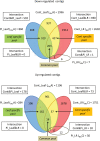Endogenous rhythmic growth in oak trees is regulated by internal clocks rather than resource availability
- PMID: 26320242
- PMCID: PMC4765786
- DOI: 10.1093/jxb/erv408
Endogenous rhythmic growth in oak trees is regulated by internal clocks rather than resource availability
Abstract
Common oak trees display endogenous rhythmic growth with alternating shoot and root flushes. To explore the mechanisms involved, microcuttings of the Quercus robur L. clone DF159 were used for (13)C/(15)N labelling in combination with RNA sequencing (RNASeq) transcript profiling of shoots and roots. The effect of plant internal resource availability on the rhythmic growth of the cuttings was tested through inoculation with the ectomycorrhizal fungus Piloderma croceum. Shoot and root flushes were related to parallel shifts in above- and below-ground C and, to a lesser extent, N allocation. Increased plant internal resource availability by P. croceum inoculation with enhanced plant growth affected neither the rhythmic growth nor the associated resource allocation patterns. Two shifts in transcript abundance were identified during root and shoot growth cessation, and most concerned genes were down-regulated. Inoculation with P. croceum suppressed these transcript shifts in roots, but not in shoots. To identify core processes governing the rhythmic growth, functions [Gene Ontology (GO) terms] of the genes differentially expressed during the growth cessation in both leaves and roots of non-inoculated plants and leaves of P. croceum-inoculated plants were examined. Besides genes related to resource acquisition and cell development, which might reflect rather than trigger rhythmic growth, genes involved in signalling and/or regulated by the circadian clock were identified. The results indicate that rhythmic growth involves dramatic oscillations in plant metabolism and gene regulation between below- and above-ground parts. Ectomycorrhizal symbiosis may play a previously unsuspected role in smoothing these oscillations without modifying the rhythmic growth pattern.
Keywords: Ectomycorrhiza; Piloderma croceum; Quercus robur; RNASeq; growth cessation; stable isotope labelling..
© The Author 2015. Published by Oxford University Press on behalf of the Society for Experimental Biology.
Figures




Similar articles
-
Transcriptome analysis in oak uncovers a strong impact of endogenous rhythmic growth on the interaction with plant-parasitic nematodes.BMC Genomics. 2016 Aug 12;17(1):627. doi: 10.1186/s12864-016-2992-8. BMC Genomics. 2016. PMID: 27520023 Free PMC article.
-
Large scale transcriptome analysis reveals interplay between development of forest trees and a beneficial mycorrhiza helper bacterium.BMC Genomics. 2015 Sep 2;16(1):658. doi: 10.1186/s12864-015-1856-y. BMC Genomics. 2015. PMID: 26328611 Free PMC article.
-
Tree Response to Herbivory Is Affected by Endogenous Rhythmic Growth and Attenuated by Cotreatment With a Mycorrhizal Fungus.Mol Plant Microbe Interact. 2019 Jun;32(6):770-781. doi: 10.1094/MPMI-10-18-0290-R. Epub 2019 Jul 7. Mol Plant Microbe Interact. 2019. PMID: 30753106
-
Cross talks at the morphogenetic, physiological and gene regulation levels between the mycobiont Piloderma croceum and oak microcuttings (Quercus robur) during formation of ectomycorrhizas.Phytochemistry. 2007 Jan;68(1):52-67. doi: 10.1016/j.phytochem.2006.09.028. Epub 2006 Nov 13. Phytochemistry. 2007. PMID: 17098265 Review.
-
The regulation of plant growth by the circadian clock.Plant Biol (Stuttg). 2012 May;14(3):401-10. doi: 10.1111/j.1438-8677.2011.00548.x. Epub 2012 Jan 27. Plant Biol (Stuttg). 2012. PMID: 22284304 Review.
Cited by
-
Transcriptome analysis in oak uncovers a strong impact of endogenous rhythmic growth on the interaction with plant-parasitic nematodes.BMC Genomics. 2016 Aug 12;17(1):627. doi: 10.1186/s12864-016-2992-8. BMC Genomics. 2016. PMID: 27520023 Free PMC article.
-
Circadian rhythms have significant effects on leaf-to-canopy scale gas exchange under field conditions.Gigascience. 2016 Oct 20;5(1):43. doi: 10.1186/s13742-016-0149-y. Gigascience. 2016. PMID: 27765071 Free PMC article.
-
Metabolomics and transcriptomics to decipher molecular mechanisms underlying ectomycorrhizal root colonization of an oak tree.Sci Rep. 2021 Apr 21;11(1):8576. doi: 10.1038/s41598-021-87886-5. Sci Rep. 2021. PMID: 33883599 Free PMC article.
-
Ectomycorrhizal fungus supports endogenous rhythmic growth and corresponding resource allocation in oak during various below- and aboveground biotic interactions.Sci Rep. 2021 Dec 8;11(1):23680. doi: 10.1038/s41598-021-03132-y. Sci Rep. 2021. PMID: 34880358 Free PMC article.
-
Oak displays common local but specific distant gene regulation responses to different mycorrhizal fungi.BMC Genomics. 2020 Jun 12;21(1):399. doi: 10.1186/s12864-020-06806-5. BMC Genomics. 2020. PMID: 32532205 Free PMC article.
References
-
- Alaoui-Sossé B, Parmentier C, Dizengremel P, Barnola P. 1994. Rhythmic growth and carbon allocation in Quercus robur. 1. Starch and sucrose. Plant Physiology and Biochemistry 32, 331–339.
-
- Angay O, Fleischmann F, Recht S, Herrmann S, Matyssek R, Oßwald W, Buscot F, Grams TEE. 2014. Sweets for the foe—effects of nonstructural carbohydrates on the susceptibility of Quercus robur against Phytophthora quercina . New Phytologist 203, 1282–1290. - PubMed
-
- Bergervoet JH, Jing HC, Van Den Hout JW, Delmondez de Castro R, Kunneman BP, Bino RJ, Groot SP. 1999. Expression of beta-tubulin during dormancy induction and release in apical and axillary buds of five woody species. Physiologia Plantarum 106, 238–245.
-
- Buscot F, Herrmann S. 2007. Cross talks at the morphogenetic, physiological and gene regulation levels between the mycobiont Piloderma croceum and oak microcuttings (Quercus robur) during formation of ectomycorrhizas. Phytochemistry 68, 52–67. - PubMed
Publication types
MeSH terms
Substances
LinkOut - more resources
Full Text Sources
Other Literature Sources

